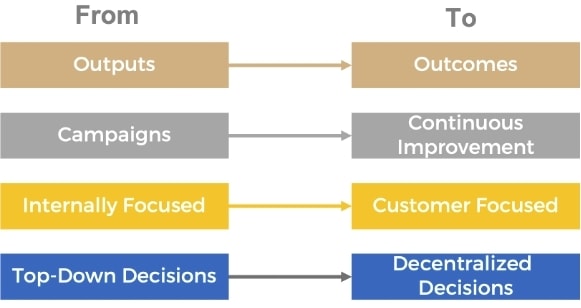Business agility is all the rage these days. Management consultants peddle Agile methodology as a tonic to fend off nimble challengers, a vaccine to quell the disruptions of COVID-19, or just a panacea for whatever ails your company.
But achieving business agility is more difficult than training a few of your staff members as Agile scrum masters and implementing daily standups. It requires that all levels of your organization—workers, middle management, and, perhaps especially, the C-suite—shift their beliefs and behaviors in four fundamental ways:

Shift 1: From a Focus on Outputs to a Focus on Outcomes
Let's face it: The majority of marketing departments and agencies are content and advertising factories. They churn out emails, blog posts, advertisements, webpages, and other promotional materials like an assembly line. They then justify all the activity with vanity metrics: email opens, blog traffic, reach and frequency of ads, webpage views, and more.
But that approach requires asking these questions:
- Do customers want more marketing noise?
- Who, on the business side, cares?
- Who believes the vanity metrics matter?
Marketing professionals—and others on teams that hope to be more than a support function to their core business—need to focus on outcomes: sales, revenue, and profitability.
Though this might seem obvious, a specific focus on outcomes (and the customer behaviors that lead to those outcomes) can get lost in organizations as you move down from the C-suite. Yet, a focus on outcomes must be ubiquitous in your organization. It's not enough to lead a cheer for sales and profitability.
Many employees, individual contributors, and middle managers can't see how their work has on impact on the big picture. CMOs and other senior leaders therefore need to help them identify the specific customer behaviors that lead to increases in revenue or higher margins.
For example, rather than measuring webpage views, marketers should be asking what kinds of visitors and visitor website behaviors contribute to increases in revenue.
Shift 2: From Campaigns to Continuous Improvement
Traditional marketing campaigns take weeks of planning. They require the coordination of multiple teams and skill sets, from marketing strategy to creative development to Web deployment to testing and measurement. Most campaigns run once, and victory is declared with whatever metrics tell the story of success.
Many marketers think in terms of campaigns. But everyone in your business needs to think in terms of continuous, incremental improvements instead.
Continuous improvement starts with an idea—a hypothesis about what might work or perform better. That hypothesis is tested on a small scale. If it fails, there's no need to justify the test with vanity metrics. It failed; try something else.
Tweak the idea, and test it again.
Some tweaks may result in no improvement, but others may generate massive and unexpected positive results. Only once an idea is vetted and optimized should it be deployed at scale with campaign-size budgets and full customer reach.
Shift 3: From an Internal Focus to a Customer Focus
Customer focus can deliver real results:
- Customer-focused companies achieved compound annual growth rates 7-30% higher than those of peers in their industry who were less so, Forrester Research found.
- Likewise, 49% of companies with strong customer-success programs have double-digit year-over-year revenue growth, according to the most recent Deloitte study of enterprise customer success.
Agile provides specific techniques to improve customer focus, including the use of user stories, personas, and customer journeys. Agile also encourages decision-making based on customer data and analytics rather than opinions and conventions.
Companies with robust marketing technology implementations (or stacks, as they are known) can achieve much greater levels of personalization for their marketing, which leads to happier customers who receive fewer, more targeted promotions and advertisements.
Shift 4: From Top-Down to Decentralized Decision-Making
The shift to decentralized decision-making may be the most difficult—and the most important—of the four shifts.
An Agile implementation that retains the delays and rework associated with top-down approvals will inevitably fail. Approvers create bottlenecks, morale suffers as a consequence, and the hoped-for improvements in speed and productivity fail to materialize.
Decentralized decision-making has many benefits: improved responsiveness to customers, greater creativity and harnessing of talent, more accountability, and improved morale.
But achieving those results is hard. Senior management needs to give up some control, and though necessary that's not sufficient; lower-level leaders and individual contributors must also change their behaviors. Many individual contributors, when presented with the opportunity to make decisions, show reluctance. They hesitate. They ask leaders to take responsibility for the final decisions.
Senior leaders must ensure that people understand it's OK to fail, particularly if they've followed a good decision-making process.
* * *
Business agility requires shifts in mindset at every level of an organization. In addition to training in Agile's methodologies and practices, organizations must invest in the above cultural shifts if they hope to realize long-term agility and success.
More Resources on Business Agility
Agility vs. Speed: How Agile Marketing Can Manage Volatile Times




